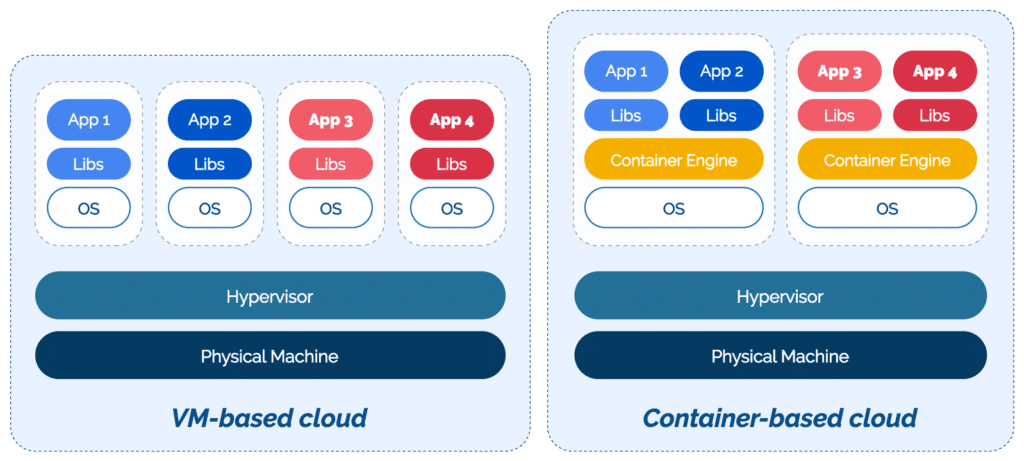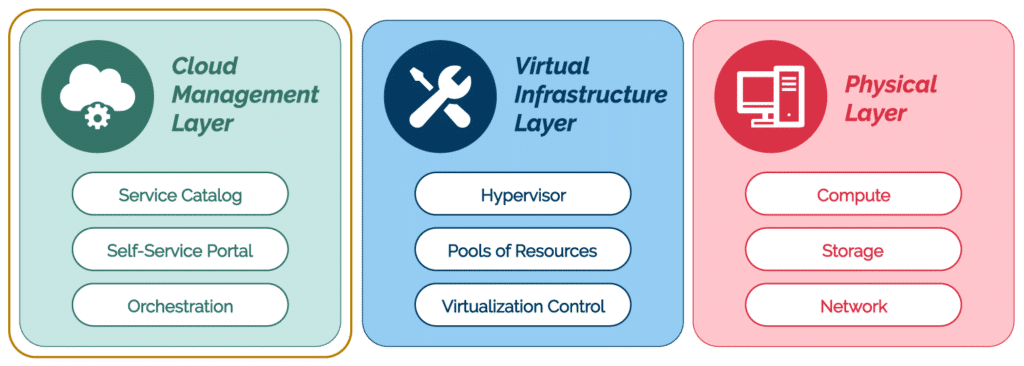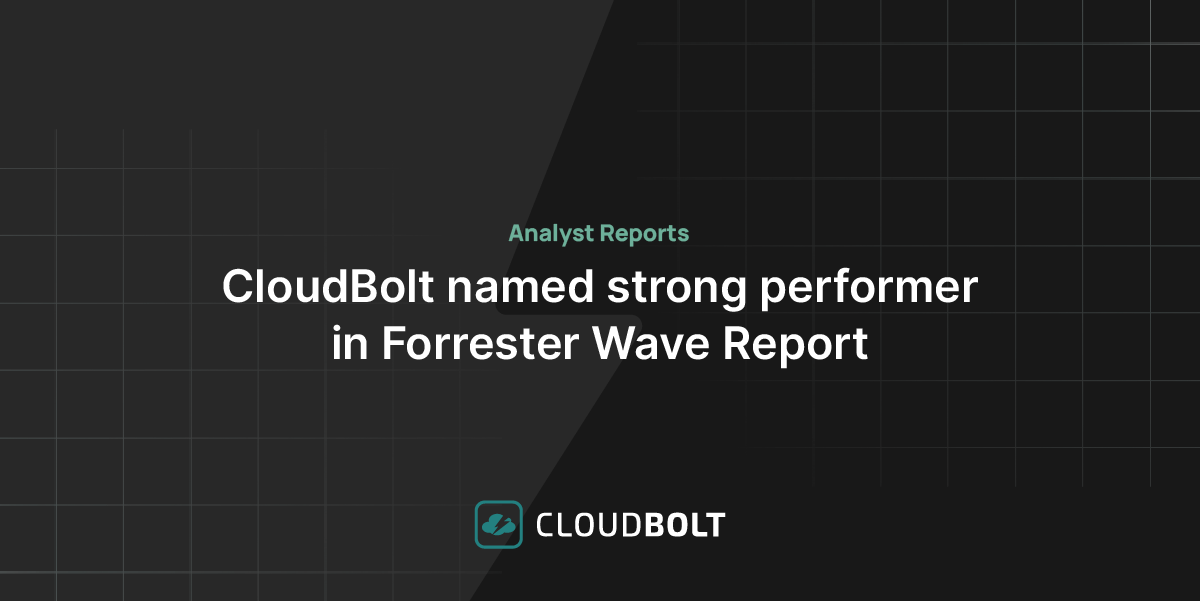Designing Scalable Private Cloud Architecture: Recommendations & Considerations

Over the last decade, cloud computing has reshaped the IT landscape, with public cloud providers capturing most of the spotlight. This focus has often left private cloud solutions in the shadows. However, when designed and implemented correctly, private clouds offer competitive advantages in long-term TCO, customizability, and security.
Thanks to cloud management platforms (CMPs), modern private clouds have now transformed into streamlined, user-friendly environments. These platforms abstract infrastructure complexities, offering intuitive portals for tasks like resource provisioning, monitoring, and automation. This evolution not only accelerates adoption and enhances the private cloud experience but also offers a competitive edge over public platforms.
This article explores the main components and best practices for implementing efficient private cloud architecture.
Key considerations for your private cloud architecture
The table below lists the recommendations and considerations when building a private cloud.
| Best Practice | Description |
|---|---|
| Customize your private cloud architecture | The biggest asset of building and owning your cloud is the ability to tailor it to your organization’s needs and not overburden it with unnecessary services. |
| Apply modern infrastructure management practices | DevOps, GitOps, SRE, and other current-day infrastructure management practices can make your private cloud environment more efficient. |
| Ensure a modern consumer experience | Modern private clouds, powered by cloud management platforms (CMPs), simplify operations by abstracting infrastructure complexities and providing users with all the convenience they can get from a public cloud provider. |
| Leverage your available talent | The available engineering talent is a significant factor in choosing the technology stack for your new infrastructure. |
| Apply in-depth security | The absence of adequate security practices can instantly negate the inherent private cloud security benefits. |
| Plan for capacity changes | Every resource, from CPU and memory availability to a switch port or power availability in a rack needs to be accounted for. Some workloads are more suitable for a private cloud than others. |
What is a private cloud?
One of the main attractions of the public cloud is its ready-to-be-consumed IaaS (infrastructure as a service), PaaS (platform as a service), and SaaS (software as a service) services.
The private cloud, on the other hand, is all about an organization owning and operating its cloud infrastructure. This typically includes managing the data center facilities (owned by the organization or colocated) and building the hardware stack’s physical server and network infrastructure. Additionally, you can install the desired virtualization and containerization software stack, design the identity and access management solution, and take care of the management layer.
The management layer is of essential importance here. A private cloud is sometimes reduced to hosting an organization’s virtualized on-premise infrastructure. But without modern resource management and developer-oriented self-service capabilities, it is just an IT infrastructure, a significantly different context to a private cloud setup.
Benefits of a private cloud architecture
There is significant planning involved in architecting and operating a private cloud.
With a much broader responsibility scope, it requires more layers to care for, and there is no single perfect solution to choose for each layer.
However, despite the added complexity, the private cloud model also brings some additional benefits as explained below.
Potential for a lower TCO
Public cloud providers allow you to start quickly, choose from hundreds of services, and have no upfront investment. Yet over a few years, the TCO of the public cloud expands significantly, especially if governance and financial management (FinOps) are not properly implemented. In contrast, if competent engineers are already available, and the workloads have consistent utilization over time, the private cloud TCO (total cost of ownership), including rollout, operations, and hardware costs, can be significantly lower over 2-5 years.
Complete ownership of the server infrastructure
Public cloud providers have gone to extreme lengths to introduce customer-managed encryption keys, hardware-based secure enclaves, and other trusted computing functionality. Nevertheless, some regulatory requirements and concerns about data locality remain. This is especially relevant in the European Union, in the context of and the cloud provider’s ability to access customer data. A private cloud gives you the infrastructure capabilities to meet the strictest regulatory requirements.
Ability to build close to a centralized location
The major public cloud providers have hundreds of data centers around the globe, covering most customer cases. However, a local private cloud might be preferred when operating in a country with no major cloud provider data centers, or due to compliance or critical performance requirements. It improves efficiency when serving customers concentrated in a narrow geography.
Inherent security benefits
Public cloud providers host the infrastructure of thousands of high-profile companies, making them lucrative targets for cybercriminals. Even with the most talented engineers that the public cloud providers employ, there are no guarantees that mistakes will not be made. In contrast, the private cloud is built for a single tenant—your company. It requires significantly less elaborate security boundary design for the identity, management plane, compute, and storage layers. Potential hardware security vulnerabilities have less impact, and you can further restrict access to the cloud management plane.
“Suddenly, I can offer an engineer productivity! Where it used to take them roughly 40 hours to build up a system to overlay their tools, I deliver all of that in minutes with CloudBolt.”
The right hardware for the required workloads
Even the seemingly unlimited capacity of public cloud vendors can sometimes be restrictive. Instead, private cloud architecture gives you the ability to choose the underlying infrastructure to build on, and you can tune it to match the workloads that you intend to run perfectly. It may be counter-intuitive, but having hardware dedicated to one company’s usage is particularly valuable in the event of a natural disaster with a broad scope, such as an earthquake. In such a scenario, hundreds of companies will be relocated to another public cloud region, with capacity for only a small percentage of the workloads that failover. In contrast, a company with dedicated hardware in two or three global locations won’t compete with other companies during disaster recovery.
Main components of your private cloud
The public cloud provides management overlays, self-service portals, and APIs. While the private cloud has evolved from its roots in virtualizing the private data center, it can also go beyond offering IaaS-based virtual servers on demand. An external management platform has become essential to most successful private cloud deployments. This final management plane is the component that elevates the on-premise server infrastructure to a modern private cloud.
Core infrastructure
The underlying physical infrastructure is the bedrock of your private cloud architecture. It starts with data center facilities with redundant power delivery and network connectivity. It is rarely feasible for larger organizations to build a Tier III data center facility, and colocation is most often the preferred choice for organizations of any size. Colocation allows transferring part of the responsibilities to a third-party provider.
With power, cooling, connectivity, and rack space in place, the primary concern for the core infrastructure becomes servers, storage, switching, and routing. You can embrace the latest developments in the software-defined data center (SDDC) space and choose hardware from multiple vendors.
Hyper-Converged Infrastructure
Hyper-Converged Infrastructure (HCI) brings the convenience of utilizing commodity hardware to build a highly resilient and scalable infrastructure solution. It allows the management of typically complex domains like networking and storage using a unified set of tools. Companies can choose from several different HCI solutions, varying by the level of integration and customization options.
For instance, you can choose a build-it-yourself platform with custom hardware and open-source Software Defined Networking (SDN) and Software Defined Storage (SDS) solutions. On the other end of the spectrum, HCI includes fully integrated systems, which can be scaled only with the approved nodes from that particular vendor, even covering most of the virtualization and containerization layer.
The situation can be more complex when operating a more classical hosting infrastructure with a dedicated storage area network (SAN), standalone compute nodes, and a switching infrastructure with a completely disconnected management plane. Nevertheless, any current-day (as in “still within the extended warranty period”) piece of infrastructure equipment features APIs that could be leveraged to simplify the management process.
Virtualization and containerization layer
When designing a private cloud, choosing a hypervisor and containerization technology is significant.
Hypervisor
The hypervisor has been central to an on-premise hosting infrastructure for 15 years. With substantial advancements made among the competitors, there are several options, both on the commercial and the free and open source front. Given the comparable features of the core hypervisor capabilities, the surrounding ecosystem, support options, and additional functionality are the primary factors to consider when choosing the virtualization platform. For example:
- Available tooling for backup solutions
- Convenience of the management interfaces to administer the hypervisor
- Compatible SDS and SDN options.
Technically, migrating virtual machines from one hypervisor to another or even running distinct virtualization infrastructures with different hypervisors is easy to achieve. Nevertheless, the additional work involved in migrations or the operational expenses of running more infrastructure components are always best avoided.

“Developers are overwhelmed by the amount of security configurations that are needed to secure the cloud…they no longer have to be security experts or worry about creating vulnerabilities for the organization.”
Containerization technology
The containerization orchestration platform has become an essential component of the private cloud. While bare-metal deployments are feasible when the highest performance is desired, containerized workloads typically run on virtual machines. Containers provide a lightweight method to package and deploy applications. They enable rapid development and scaling of applications and eliminate dependency problems.
Kubernetes is the de-facto container orchestration tool for the overwhelming majority of companies. However, configuring and operating the vanilla flavor and building all the additional components on top of it is challenging and time-consuming. Because of that, often, it is more beneficial to consider a complete container orchestration platform like Rancher or OpenShift.
Cloud management platform
The final piece of the puzzle is the cloud management platform.

While many integrated solutions for HCI have great management tools for infrastructure engineers and administrators, very few platforms offer an end-user-focused experience complete with easily consumable services that users can deploy with no additional technical knowledge.
For example, consider a cloud management platform like CloudBolt. It is a hybrid cloud management platform that integrates with other configuration management tools like Ansible or Terraform in your environment to provide a single pane of glass for automating the tasks involved in managing the provisioning, configuration, security, and cost. It also provides an intuitive user interface that empowers application owners to self-service their basic needs relieving the burden from the operations teams. A tool like CloudBolt can provide users of a private cloud with the same user experience as a public cloud, where a wide range of services can be provisioned via clicks on a simple user interface, empowering application owners to be self-sufficient while reducing operating costs.
Private cloud architecture best practices
Below are some best practices you can follow when building your private cloud.
Customize your private cloud architecture
The process of building a private cloud is a unique opportunity to create a product that is better suited for the intended scenario than the services available from the public cloud provider. For instance, you could design your private cloud to enhance performance, simplicity of use, regulatory compliance, or any other factor relevant to your business.
Building another AWS or Azure with just a handful of engineers is almost impossible. But that level of sophistication is hardly ever required. Instead of 100 services, the private cloud your organization is building might only need ten well-architected and engineered items in the service catalog. The most crucial thing here is to achieve great customer and developer experiences for colleagues and partners. If the end-user experience is lacking, your customers will look for simpler alternatives.
Apply modern infrastructure management practices
It is now easier than ever to integrate the infrastructure provisioning flow into the application deployment CI/CD pipelines. You can build automation in your private cloud architecture with:
- Well-documented APIs
- Third-party infrastructure-as-code (IaC) tools like Terraform or Pulumi.
- DevOps-friendly commercial offerings
For example, well-established companies like VMware and free, open-source cloud management platforms offer HTTP APIs to interact with and simplify private cloud management practices with automation. You should also apply the same philosophy to manage the core physical infrastructure as well.
Ensure a modern consumer experience
While using modern infrastructure practices is the way to increase the efficiency of your engineering teams, it is just part of a solution to a successful cloud platform. Skilled engineers can code deploy workloads using scripts and pipelines they have developed. However, less skilled employees and application owners tend to rely on more user-friendly solutions that abstract the complexity of infrastructure provisioning.
Cloud management platforms (CMPs), such as CloudBolt, help with bringing the much-required abstraction level to sophisticated underlying infrastructure automation. With a unified control plane, teams can consume private cloud resources through standardized self-service without convoluted manual processes, even for a highly complex and customized solution deployment. A CMP also facilitates governance and provides visibility into usage and costs across private and public environments.
Much like the portals of public cloud providers, this familiar interface accelerates new technology adoption and makes the most of private cloud investments by empowering users to be productive. With the right CMP solution in place, your private cloud can offer a modern developer and user experience rivaling any public platform.
Leverage your available talent
There’s no one recipe for building a private cloud. The private cloud’s implementation is a complex infrastructure project. It is a job for the engineering talent of the organization and requires skills even the most experienced public cloud experts may not have.
You may have to base certain infrastructure decisions on existing team experience with hypervisors, networking vendors, operating systems, and management platforms. The skill set of the engineers and how long they will take to learn the new platform will also contribute to deciding whether a particular component should be made in-house or purchased from a vendor. You can eliminate some of the existing gaps in automation, IaC, and GitOps practices with the help of third-party tools.
Vendor lock-ins are never a desired outcome. But you can choose that option as long as the business objectives are being met, and there is a clear path of changing the providers even after infrastructure layers are in use.
“We were surprised at how few vendors offer both comprehensive infrastructure cost management together with automation and even governance capabilities. I wanted a single solution. One vendor to work with.”
Apply in-depth security
We have already established that private cloud architecture has inherent security benefits, from not having to share the infrastructure with other tenants and having the potential to limit access to the management plane. Even with less exposure to the public internet, your infrastructure operations teams have to take care of:
- Identity and Access (IAM) system
- Configuration on the management plane
- Security updates of the physical network infrastructure.
With the entirety of the IT stack being self-managed, each of the underlying layers should be held to the highest encryption and data protection standards on its own. That means not skipping TLS even if the transfers are internal and not skimping on password complexity requirements and multi-factor authentication even for private endpoints. Security measures, aided by compliance platforms like ClouBolt, should be factored into the private cloud architecture from the start.
Plan for capacity changes
Capacity planning is crucial to running your private cloud infrastructure. With significant capital investments, purchasing many physical infrastructure components upfront may not be feasible. Expanding your global presence into a new location also results in substantial upfront investments. Ultimately, no organization should artificially limit itself only to utilize one particular infrastructure, whether private or public.
The functionality of the public cloud comes in handy for scenarios where you want to:
- Use newly released AI and data capabilities as a fully managed service
- Test an idea using rare or expensive computational resources your organization does not have the budget for
- Scale very quickly beyond your private infrastructure.
Being open to alternatives ensures that the best option is selected to meet the business objectives in the long run, which is why a hybrid cloud strategy can provide the best of both worlds.
Conclusion
Private cloud architecture brings significant business benefits if implemented correctly. It is fully customizable, potentially reduces the total cost of ownership, and has inherent security advantages. However, it requires more upfront investment in technical expertise and capital expenses. As a critical part of the IT infrastructure that your business applications rely on, it is essential to plan for high availability and operability.
Cloud management platforms like CloudBolt can significantly simplify this process, offering a middle ground for managing both resources and costs effectively. In fact, leveraging such platforms allows for a hybrid model, blending the strengths of both private and public clouds to deliver an optimized, agile cloud environment.
Related Blogs

The New FinOps Paradigm: Maximizing Cloud ROI
Featuring guest presenter Tracy Woo, Principal Analyst at Forrester Research In a world where 98% of enterprises are embracing FinOps,…




